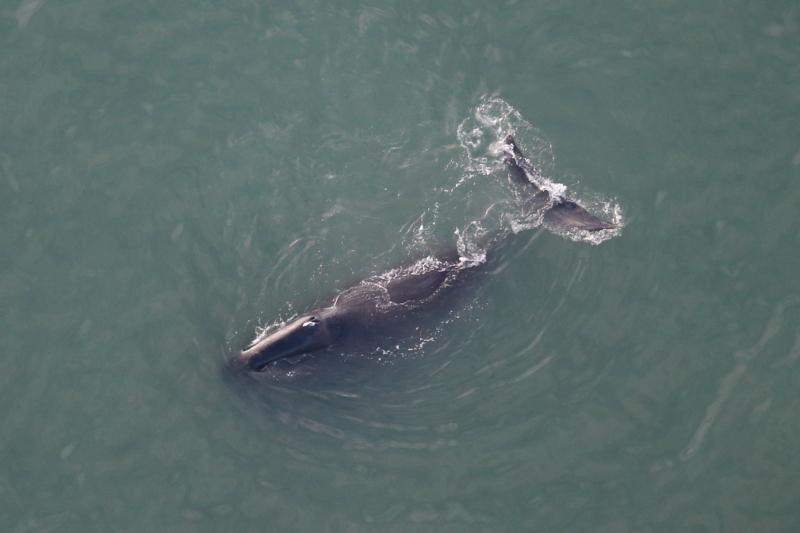In the Arctic, each year before daylight disappears and winter arrives, thousands of bowhead whales make their fall migration across the Beaufort Sea off northern Alaska. The timing of the migration is something Alaska Indigenous communities and scientists can count on. However, 2019 was not a normal year.
What Happened in 2019?
The year 2019 was unusual in several ways. It was Alaska’s hottest year on record. Sea surface temperatures were significantly warmer than average. There also were salmon die-offs across the state as river temperatures, in some areas, hit 70 degrees Fahrenheit.
The timing of the bowhead whale migration was also different. By late October, the largely subsistence-based community of Utqiaġvik, Alaska, had seen few whales. Never in recent memory had whales come so late. NOAA researchers observed that both the edge of the sea ice and the bowhead whales were farther north than in previous years of surveying the area in Bureau of Ocean Energy Management-funded aerial studies.
“Whales are a vital part of our communities. Bowheads help us to feed our communities and are central to many of our cultural traditions. Hunting whales has been our way of life for thousands of years,” said North Slope Borough Mayor Harry K. Brower, Jr.
“In 2019, the whales arrived two to three months later than normal and few came close to shore, making it difficult for hunters to reach them. We were really worried that this might become the new normal,” said Robert Suydam, senior wildlife biologist, North Slope Borough. The Bureau of Ocean Energy Management had been funding surveys since 1979 but 2019 was the last year of their funding. So, the North Slope Borough, through the efforts of Mayor Brower, supported an aerial survey in 2020 to collect data on the bowhead whale migration timing, density, distribution, and activities in the western Beaufort Sea.”
Collecting data on the bowhead whale migration in the fall of 2020 was particularly important to the community. The changes in the bowhead whale migration in 2019 meant that Utqiaġvik hunters were only able to harvest one bowhead whale very late in the season in mid-November. More typically, whales in Utqiaġvik are harvested from about mid-September through mid-October.
Highlights of 2020 North Slope Borough Survey
For scientists, conducting an aerial survey during autumn 2020 would enable them to compare results with data collected over four decades. New data could potentially shed more light on the underlying causes of the anomalous autumn 2019 bowhead migration. It also would be invaluable to local communities hoping to understand the scale of the variability in the Alaskan Arctic ecosystem and glimpse what the future might look like.
“This was a great opportunity to work with our co-management partners at the Alaska Eskimo Whaling Commission and colleagues at the North Slope Borough,” said Megan Ferguson, a research biologist, Alaska Fisheries Science Center. “The year 2020, while different than 2019, was still an unusual year. For instance, during our last flight, just north of Point Barrow, we saw what may turn out to be the highest or the second highest densities of bowhead whales we have ever seen.”
Scientists coordinated closely with hunters to ensure that the aerial survey didn’t impact hunting activities.
Over the course of the month-long survey, which ran from September 17 to October 15, the team covered 8,905 miles. They spent 57 hours, more than the average work week, in the air. Most of the survey effort occurred in the area between Prudhoe Bay and Point Barrow. They encountered 770 bowhead whales, including 24 calves. Almost half of these animals were observed in concentrated feeding aggregations between Point Barrow to Dease Inlet on the last day of the survey.
“We knew the whales were eating because we saw whales with mud on their rostrums [front of their heads]. They also were skim feeding - swimming with their mouths open. They do this to collect and filter their prey, which in this case was krill. There were a lot of birds both on the water and flying overhead,” said Ferguson.
Perfect Environmental Conditions Create a “Krill Trap”
Scientists attribute the dense whale concentrations to optimal feeding conditions set up by perfect environmental conditions. Winds near Utqiaġvik during late summer and early autumn this year were favorable for creation of a “krill trap.” There were repeated occurrences of pronounced upwelling, which brings krill onto the shallow waters of the continental shelf. This was followed by relaxed winds that could have promoted the aggregation of krill. Discharge from the Meade River into Dease Inlet in the early part of October was more than twice the average amount. That freshwater discharge potentially creates stronger nearshore weather patterns outside the barrier islands, which can further concentrate krill and promote bowhead feeding.
Throughout the survey, scientists also observed small numbers of gray, humpback, and fin whales and clusters of beluga whales. They also encountered a few harbor porpoises, walruses, seals and a polar bear mom and her cub. The polar bears were feeding on a large whale carcass located on a barrier island west of Camden Bay.
Ferguson was joined by long-term research partners from Cooperative Institute for Climate, Ocean, and Ecosystem Studies at the University of Washington, Amelia Brower and Amy Willoughby, and Clearwater Air. Due to COVID-19, NOAA Fisheries, North Slope Borough and research partners adopted strict protocols. This ensured the safety of the community of Utqiaġvik (where the team was housed) and the observers and pilots. Overall, it was a really successful survey on all counts.





